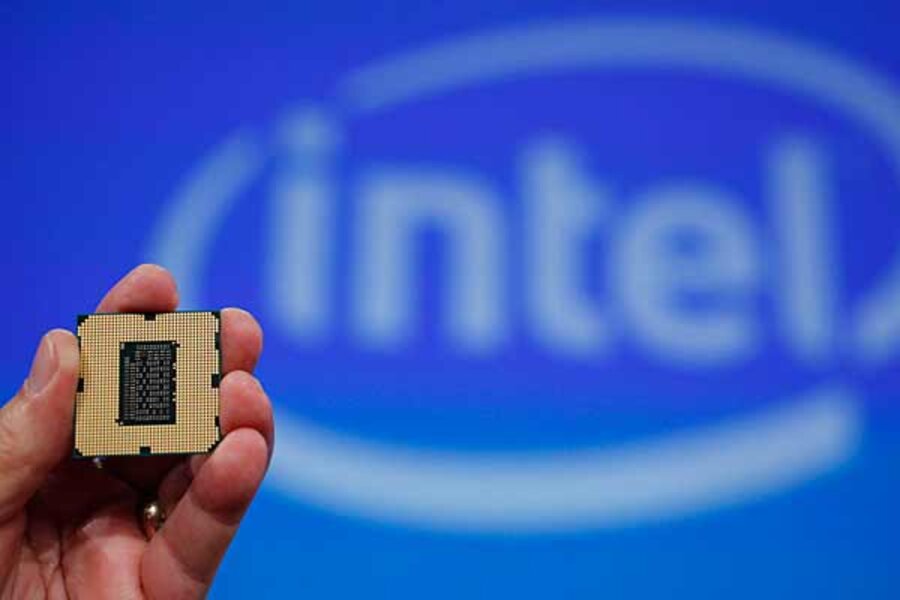Intel investment a big vote of confidence for US economy
In a big vote of confidence for the US economy, computer chipmaker Intel says it will hire 800 to 1,000 new workers in Oregon and Arizona as it spends up to $8 billion upgrading four factories and building one new one. All of that construction will create 6,000 to 8,000 hard hat positions, Intel estimates.
Is this finally a sign the jobs market is starting to improve? Possibly.
The jobs market has been so lackluster for so long economists are loathe to go out on a limb and predict one company taking the plunge will turn things around. But, they say the Intel move is certainly the type of event that may cause corporate America to take notice – and maybe put their cash back into new factories instead of Treasury bills. Some economists go so far as to say the Intel decision may represent the start of a trend – US companies taking advantage of the lower-valued US dollar to make products at home.
“If the Intel plans go through, it may be a signal of burgeoning improvement in business conditions,” says Kurt Rankin, an economist at PNC in Pittsburgh. “You don’t see many companies step out like this without some kind of internal projections that the economy is improving.”
To economist Mark Zandi of Moody’s Analytics, the most important part of the Intel announcement is that the company decided to build and upgrade its factories in the US.
“I think it highlights the US is very competitive in the global economy,” he says. “This is very positive news and I think we will be hearing similar news from other companies in the future.”
In fact, Mr. Zandi says the Intel decision is part of a “transition” that is now starting to take place in the US economy.
“As the US consumer becomes more cautious, the void has to be filled by stronger exports and the business decision to support that.”
The Intel decision tells economist Joel Naroff of Naroff Economics in Holland, Pa., that the advantages of producing goods offshore are diminishing, in part because the US dollar is in a long-term declining trend.
China has long been an attractive country for companies to take their production outfits to, in part, some say, because it has manipulated its currency to keep it artificially weak.
“I believe China has to have their currency move [up] dramatically – we’re talking about a 50 percent change,” says Mr. Naroff. Such a currency move would last for some time, he says. “When you are building plants like Intel, you are talking about factories that will still be producing 20 years down the road.”
Intel has maintained a strong US base for making its products for some time. According to the company, three quarters of its revenues come from overseas, but three quarters of its microprocessors are made in the US.
According to Intel, the construction is thanks partly to a buoyant computer industry, which Intel says is shipping 1 million PCs per day.
“The upgraded [fabrication plants] create the capacity for the continued growth of the PC market segment and additional computing markets Intel is addressing, such as mobile and embedded computing,” said the company in an announcement.
Intel is calling its investment the construction of the next generation of its manufacturing technology. The Oregon facility is scheduled to start-up in 2013.
The actual construction of the chip production plants will be a boon to both Oregon and Arizona, which Zandi calls “among the hardest hit states in the country.”
In fact, the scale of the Intel plan makes it one of the largest private construction projects in the nation, says Ken Simonson, chief economist at the Associated General Contractors of America in Arlington, Va.
“This is maybe one of the top-five or maybe even top projects in the world at this point,” says Mr. Simonson. “There will be a need for a lot of skilled workers.”
Those skills will be in demand because the plants themselves will be built to very high standards, requiring sophisticated air and water filtration systems. “The plant will have higher purity than a hospital,” says Simonson.
One of the plants will be in greater Phoenix and the second facility will be outside of Portland. The construction industry in those cities has been pounded, he says. In the case of Phoenix, construction employment is down 53 percent from its peak in 2006, and Portland's is down 36 percent, says Simonson. Nationally, construction employment is down 27 percent.
“These are a couple of hurting states,” he says.





